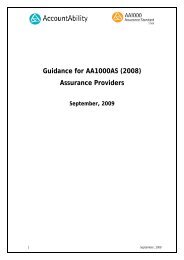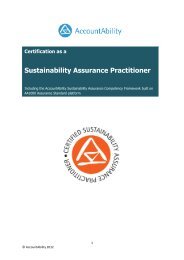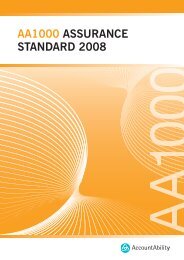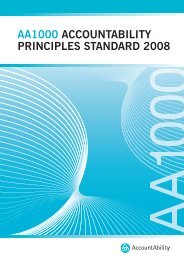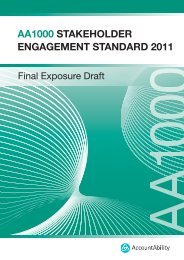The Stakeholder Engagement Manual Volume 2 - AccountAbility
The Stakeholder Engagement Manual Volume 2 - AccountAbility
The Stakeholder Engagement Manual Volume 2 - AccountAbility
You also want an ePaper? Increase the reach of your titles
YUMPU automatically turns print PDFs into web optimized ePapers that Google loves.
STAGE 4<br />
• Use the table, as well as the questions in the table below to refl ect on a small<br />
number of specifi c approaches that are suitable. Th e Levels of <strong>Engagement</strong><br />
table, downloadable from www.accountability.org.uk also helps you to<br />
consider their suitability. Remember that all approaches are fl exible and<br />
adaptable. Often you will fi nd that you need several approaches, and especially<br />
high-level ones are often preceded or accompanied by more low-level<br />
approaches such as surveys or one-on-one meetings to prepare, collect some<br />
basic information or ensure that there are some fundamental agreements on<br />
important aspects.<br />
• Once you have selected an approach, discuss again the possible outcomes of it,<br />
and if this is what your business wants and is ready to deal with. Finally,<br />
double check any decision on approaches with your original strategic<br />
engagement objectives, to ensure that they do contribute to reaching them.<br />
Questions for Assessing <strong>Engagement</strong> Methods<br />
Organisational<br />
and <strong>Stakeholder</strong>s'<br />
Objectives and Needs<br />
1. Does it help us to establish the kind of relationship that we want?<br />
2. Can it generate the short- and / or long-term outputs we need to reach our<br />
strategic objectives?<br />
3. Will it generate the qualitative or quantitative information that the business needs<br />
for making its decisions?<br />
4. Do I have suffi cient resources and time for applying this method / mix of methods?<br />
<strong>Stakeholder</strong> Profi les 5. Does it work for the stakeholders that I want to engage with?<br />
6. Considering the stakeholders’ mobility, is it suitable for their current location?<br />
7. Does it suit the stakeholders’ current level of awareness and understanding?<br />
8. What practical issues need to be considered and addressed in order to make the<br />
engagement accessible/attractive to them (see also Stage 3)?<br />
Relationship Context 9. Do we currently have a relationship with these stakeholders that makes this<br />
approach applicable?<br />
10. Have we known the stakeholders long enough?<br />
11. Is it suitable for the number of people we need to deal with?<br />
Issue Context 12. Is it appropriate for the level of maturity of the issue?<br />
13. Is the issue maybe too sensitive for this approach?<br />
14. Does it match with existing policy or legislative requirements that apply to the<br />
stakeholder group or issue?<br />
15. If the issue requires multi-stakeholder involvement, does this approach work for it?<br />
THE PRACTITIONER'S HANDBOOK ON STAKEHOLDER ENGAGEMENT | 99



